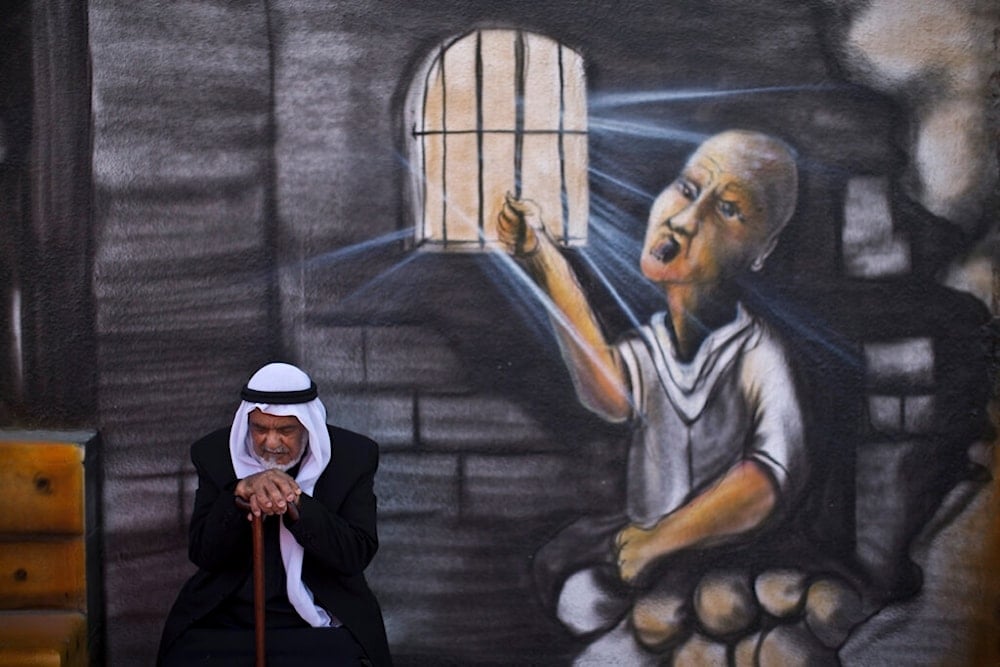Gaza's cultural heritage protected in Geneva from Israeli attacks
The Museum of Art and History will display 44 items discovered in Gaza, including amphoras, statuettes, vases, oil lamps, and figurines, as part of a preservation exhibition of Gazan culture.
-

Palestinian refugee Shaher Alkhateeb, 73, who witnessed the Nakba, poses for a picture in front of a wall painted with a mural depicting a prisoner jailed in "Israel", June 16, 2024. (AP)
Archaeological artifacts from the Gaza Strip will be exhibited in Geneva as the city continues to safeguard the heritage of a region ravaged by a year of conflict.
The "Patrimony in Peril" exhibition at the Museum of Art and History will display 44 items discovered in Gaza, including amphoras, statuettes, vases, oil lamps, and figurines.
"It's a part of Gaza's soul. Its identity, even," Beatrice Blandin, the exhibition's curator, told AFP, stressing that heritage preserves the history of the land and its people.
The 44 treasures on display are part of a much bigger, 530-piece collection of objects from Gaza that have been stored for preservation in Geneva since 2007, unable to return to their home.
The exhibition is expected to run from October 6 until February 9, and will showcase artifacts from several Arab countries, including Syria, Libya, and Egypt, highlighting the role of museums in protecting cultural artifacts from destruction, theft, and conflict, while also reminding visitors that intentionally destroying heritage is considered a war crime.
In this context, Geneva city councilor Alfonso Gomez slammed the intentional suppression and erasure of culture, saying "The forces of obscurantism understand that cultural property is what is at stake for civilization, because they have never stopped wanting to destroy this heritage."
MAH director Marc-Olivier Wahler told AFP that cultural heritage becomes a target for aggressors during conflict, as they try to erase a people or region's history and identity, but reassuring that museums and regulations exist to protect that heritage.
Some of the artifacts originally belonged to the Palestinian Authority, while the rest were owned by Palestinian entrepreneur Jawdat Khoudary, who transferred ownership to the PA in 2018. These items, representing life from the Bronze Age to the Ottoman era, were brought to Geneva in 2006 for the "Gaza at the Crossroads of Civilisations" exhibition, inaugurated by Palestinian President Mahmoud Abbas.
Although they were intended to become part of an archaeological museum in Gaza, they remained in Geneva for 17 years due to the inability to ensure their safe return.
'Israel' continues wiping out Palestinian identity
Since "Israel's" genocidal war in Gaza began last year, cultural sites in the Palestinian territory have suffered significant damage, according to the United Nations' cultural organization.
UNESCO has confirmed damage to 69 sites, including 10 religious sites, 43 historically or artistically significant buildings, two repositories of movable cultural property, six monuments, one museum, and seven archaeological sites.
Among the most significant is the Saint Hilarion complex, a 4th-century monastery located in Gaza, which has been placed on UNESCO's endangered sites list due to "Israel's" ongoing onslaught in the Strip, the organization said.
The site, which is considered one of the oldest monasteries in the Middle East, was put on the list due to "imminent threats" highlighted by the Palestinian authorities.
"It's the only recourse to protect the site from destruction in the current context," UNESCO World Heritage Centre Director Lazare Eloundou Assomo said to AFP, referring to the Israeli occupation's war on Gaza.
The monastery was granted "provisional enhanced protection," the highest level of security permitted by the 1954 Hague Convention, in December by the Committee for the Protection of Cultural Property in the Event of Armed Conflict.
Read more: Israeli war 'burned humans, stones, and trees': Gaza archaeologist

 4 Min Read
4 Min Read








